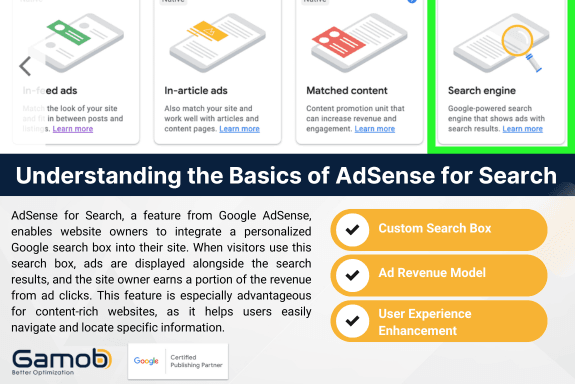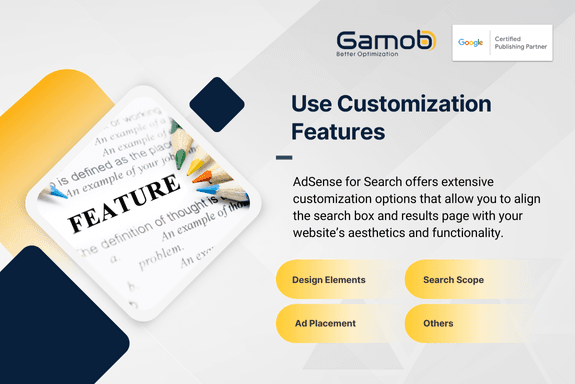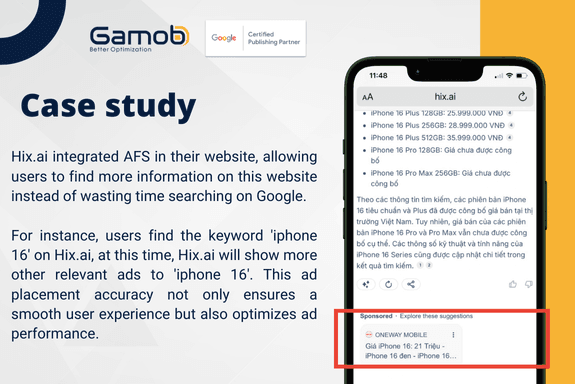
Subscribe to receive the latest blog posts to your inbox every week.
By subscribing you agree to with our Privacy Policy.
In the ever-evolving landscape of digital monetization, Google AdSense for Search (AFS) has emerged as a powerful tool for website owners to enhance user experience while generating additional revenue. AFS seamlessly integrates a customized Google search box into your site, enabling users to find relevant content effortlessly while presenting targeted ads that generate income with every click.
To truly unlock the earning potential of AdSense for Search, publishers need more than just the basics of implementation; they require a strategic approach. This blog explores how to maximize earnings with AFS and delves into the future of this innovative monetization platform.
1. Understanding the Basics of AdSense for Search
Before diving into advanced strategies, it’s essential to understand how AFS works:
- Custom Search Box: A tailored Google-powered search box embedded into your website.
- Ad Revenue Model: Ads relevant to user search queries appear alongside results, and publishers earn revenue when users click these ads.
- User Experience Enhancement: Improves navigation and usability, especially on content-heavy sites.

This combination of functionality and monetization creates a win-win for both users and publishers. However, the effectiveness of AFS depends on how well it’s implemented and optimized.
>> Read more details here: How can Adsense for search apply on your website?
2. Focus on Search Intent
At the heart of a successful AFS strategy lies understanding user behavior and intent. Search intent refers to the purpose behind a user’s query, whether it’s informational, navigational, or transactional.
How to Leverage Search Intent:
- Use tools like Google Analytics or Search Console to identify popular queries on your site.
- Segment keywords based on user intent (e.g., "how-to guides" vs. "product comparisons").
- Ensure that ads displayed in search results align closely with these queries.
Actionable Tip:
If you manage an AI-powered educational platform, prioritize search terms related to high-demand topics or trending courses. For instance, queries like "AI for business" or "Python programming basics" should display ads for relevant eBooks, software, or certifications.
3. Use Customization Features
AdSense for Search offers extensive customization options that allow you to align the search box and results page with your website’s aesthetics and functionality.

Key Customization Features:
- Design Elements: Match colors, fonts, and branding to create a cohesive experience.
- Search Scope: Limit searches to specific areas of your site or expand to include broader web results.
- Ad Placement: Control where ads appear on the search results page to balance visibility and user experience.
Benefits of Customization:
A well-designed search box builds trust and encourages engagement. Users are more likely to interact with a search interface that feels native to the site rather than intrusive.
4. Monitor Performance Metrics
Data-driven decisions are crucial to optimizing AdSense for Search. Google provides detailed performance metrics through the AdSense dashboard, allowing you to track the effectiveness of your implementation.
Key Metrics to Watch:
- Click-Through Rate (CTR): Indicates how often users click on ads.
- Impressions: Measures how many times ads are displayed.
- Earnings per Search (EPS): Tracks revenue generated per search query.
How to Use Metrics Effectively:
- Identify underperforming search terms and refine ad targeting.
- Experiment with ad placements and designs to improve CTR.
- Regularly review and adapt your strategy based on data insights.
5. Strategic Placement of the Search Box
The visibility and accessibility of your search box directly impact its usage and revenue potential. Strategic placement ensures that users can easily find and use the search functionality.
Ideal Placement Options:
- Header or Navigation Bar: Ensures high visibility across all pages.
- Homepage Above-the-Fold: Captures user attention immediately.
- Sidebar or Footer: Works well for blogs or resource-heavy sites.
Placement Tip:
A/B test different placements to determine which location drives the highest search volume and engagement.
6. Balance Ads and Usability
While maximizing ad revenue is a primary goal, it’s equally important to maintain a positive user experience. Overloading search results with ads can frustrate users and diminish trust.
Best Practices for Ad Balance:
- Limit the number of ads displayed to 2-3 per page.
- Ensure ads are clearly labeled to distinguish them from organic results.
- Use Google’s ad placement guidelines to maintain compliance and usability.
7. Adhere to Google’s Policies
Non-compliance with Google’s AdSense policies can lead to account suspension or penalties. Always adhere to best practices and guidelines:
- Avoid incentivizing clicks on ads.
- Ensure that search results are relevant and not manipulated for higher revenue.
- Regularly review Google’s policy updates to stay compliant.
8. The Future of Monetization with AdSense for Search
As digital technologies evolve, so does the potential of AdSense for Search. Here are some trends that will shape its future:
Deeper Integration with AI Tools:
With AI playing an increasingly prominent role in online experiences, expect Google to introduce features that allow publishers to leverage AI algorithms for advanced ad targeting. For instance, predictive analytics could suggest optimal ad placements based on user behavior patterns.

Expansion of Shopping Ads:
The rise of e-commerce has made shopping ads a lucrative addition to AdSense. These ads, which showcase products with images and prices, will likely become a staple for platforms focused on product discovery.
Greater Customization:
Future updates may offer even more flexibility in how ads are displayed, including dynamic ad formats and tailored layouts that align with specific audience preferences.
Maximizing earnings with AdSense for Search requires a blend of strategic implementation, continuous optimization, and adherence to best practices. By understanding user intent, leveraging customization features, and monitoring performance metrics, publishers can unlock the full potential of this monetization tool.
Instead of researching and deploying AFS, you can choose Gamob as your AFS development partner. Gamob is Google Certified Publishing Partner (GCPP) that empowers over 10,000 publishers helping them deliver expert solutions in Product and User Acquisition Consultancy, Revenue & Inventory Optimization, and Inventory Quality Assurance. Our mission is to boost publishers' and ad networks' success, ensuring quality, efficiency, and sustainable growth through trusted, innovative partnerships.
---------------------
Gamob | GCPP - Empower your monetization journey
- Email: [email protected]
- Website: www.gamob.com
- Linkedin: www.linkedin.com/company/gamob-gcpp